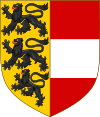Bernhard von Spanheim
Bernhard of Spanheim | |
|---|---|
Agnes of Babenberg |
Bernhard von Spanheim (or Sponheim; 1176 or 1181 – 4 January 1256), a member of the noble
Family
In 1122 Bernhard's ancestor Count
His father was Duke
Reign
Bernhard had actually been regent over the Carinthian duchy since his elder brother Duke Ulrich II had fallen seriously ill, possibly with leprosy, after he had joined the Crusade of 1197. In the conflict between the rivaling House of Hohenstaufen and the Welfs around the German throne upon the death of Emperor Henry VI, he originally continued his brother's support for their Hohenstaufen relative Philip of Swabia but turned to the Welf Otto IV after Philipp's assassination in 1208 and attended his coronation in Rome. Bernhard again switched sides to Philip's nephew Frederick II, who had been elected King of the Romans in 1212 and finally prevailed.
Bernhard remained a loyal supporter of the Hohenstaufen dynasty. He backed the efforts by Grand Master

A territorial prince (princeps terre) at his own judgement, Bernhard concentrated on regional politics and aimed at extending his estates against rivalling territorial princes like Patriarch
In turn, Bernhard entrenched a ducal centre of force comprising the city triangle of Sankt Veit, where he established a mint in 1205, Völkermarkt, and Klagenfurt, the later Carinthian capital that he had transferred to its present location in 1246. Bernhard's court in Sankt Veit was the site of festive chivalrous tournaments and a venue of minnesingers like Walther von der Vogelweide. In his Frauendienst poem, Ulrich von Liechtenstein renders his arrival in Carinthia in the guise of a Venus in 1227, when Duke Bernhard received him with the Slovene salutation Buge waz primi, gralva Venus ("God be with you, royal Venus").
Bernhard's hopes to extend his influence after the extinction of the
Marriage and children


Duke Bernhard's exalted rank corresponds to his wedding with Judith, daughter of the Přemyslid King Ottokar I of Bohemia and the Árpád princess Constance of Hungary, in 1213.[1] Four known children result from the marriage:
- Ulrich III (c. 1220–1269), Duke of Carinthia 1256–1269, Margrave of Carniola since 1248[1]
- Bernhard of Carinthia (d. before 1249)
- Margaret of Carinthia (d. before 1249)
- Patriarch of Aquileia from 1269 to 1273.[1]
The relationship with the Přemyslid dynasty became crucial, when Bernhard's son Duke Ulrich III died without heirs in 1269. His younger brother Philip was claimant to the estates of Carinthia and Carniola, he nevertheless could not prevail against his first cousin King Ottokar II of Bohemia, who in 1268 had signed an inheritance treaty with late Duke Ulrich. Though Philip even reached his enfeoffment by the Habsburg king Rudolf I of Germany in 1275, he could not assume the rule after King Ottokar II was killed at the 1278 Battle on the Marchfeld.
References
Sources
- Loud, Graham A.; Schenk, Jochen, eds. (2017). The Origins of the German Principalities, 1100-1350: Essays by German Historians. Taylor & Francis.
